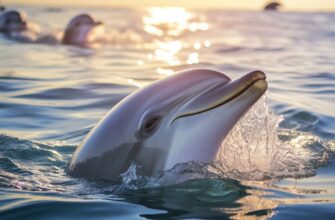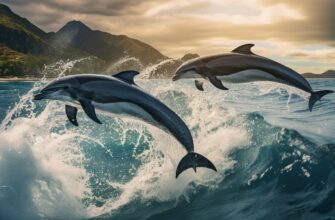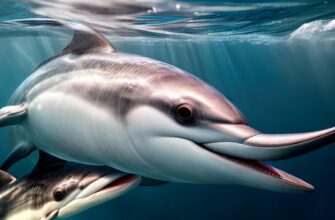Welcome to the world of dolphins, where these charismatic marine mammals are beloved by people around the globe. Dolphins are known for their intelligence, playfulness, and remarkable social interactions, making them one of the most fascinating creatures in the ocean. As ocean mammals, they play a vital role in marine life and ecosystems, and their conservation is crucial.
In this article, we will take a deep dive into the world of dolphins, exploring their various species and habitats, behavior, communication methods, and socialization, as well as their importance in ocean ecosystems. We’ll also discuss the joy of dolphin watching and the ongoing efforts to protect these enchanting creatures and their habitats.
- Key Takeaways
- Dolphin Species and Habitat
- Dolphin Species and Habitat
- Dolphin Behavior and Intelligence
- The Importance of Dolphins in Ocean Ecosystems
- Dolphin Communication and Socialization
- Dolphin Vocabulary
- Dolphin Watching and Tours
- Interesting Facts About Dolphins
- Dolphin Conservation Efforts
- Conclusion
- FAQ
- Q: What species of dolphins can be found in the ocean?
- Q: Where do dolphins live?
- Q: What behaviors do dolphins exhibit?
- Q: How intelligent are dolphins?
- Q: Why are dolphins important for ocean ecosystems?
- Q: How do dolphins communicate?
- Q: Can I go on dolphin watching tours?
- Q: What are some interesting facts about dolphins?
- Q: How can I contribute to dolphin conservation efforts?
Key Takeaways
- Dolphins are intelligent and playful marine mammals that play a significant role in maintaining the balance of ocean ecosystems.
- There are various species of dolphins found in diverse habitats around the world.
- Dolphins exhibit complex behaviors and communication methods and form tight-knit social bonds with other members of their pod.
- Dolphin watching is a popular activity that allows people to witness these magnificent creatures in their natural habitat.
- Conservation efforts are underway to protect dolphin populations and their habitats.
Dolphin Species and Habitat
Dolphins are an incredibly diverse group of marine mammals, with over 40 different species found across the world’s oceans. These species vary in size and appearance, from the 4-feet-long Maui’s dolphin to the much larger and commonly recognized bottlenose dolphin.
| Dolphin Species | Habitat |
|---|---|
| Bottlenose Dolphin | Tropical and temperate waters worldwide |
| Spinner Dolphin | Warm waters of the Pacific, Atlantic, and Indian Oceans |
| Pacific White-Sided Dolphin | North Pacific Ocean |
Dolphins can be found in almost every ocean habitat, from shallow coastal waters to deep offshore environments. Some species, like the Amazon river dolphin, even inhabit freshwater rivers in South America.
Their habitats shape their behaviors and physical characteristics. For example, dolphins found in cold waters tend to have thicker blubber to help them stay warm, while those found in warmer waters have sleeker bodies to aid swimming at high speeds.
Dolphin Species and Habitat
It is important to note that some dolphin species, like the critically endangered Maui’s dolphin, have very limited habitats and face threats from human activities. Understanding their habitats is crucial for conservation efforts and protecting these fascinating creatures for generations to come.
Dolphin Behavior and Intelligence
Dolphins are known for their remarkable intelligence and complex behavior, making them one of the most fascinating creatures in the ocean. Their behavior is shaped by their environment, social structures, and cognitive abilities, which enable them to solve problems and communicate with each other using a range of techniques.
Dolphin intelligence is among the highest of all ocean mammals, on par with primates and whales. Studies have shown that dolphins possess self-awareness, tool use, and the ability to understand abstract concepts. They also exhibit advanced problem-solving skills, which are often demonstrated while foraging or hunting prey.
Dolphin behavior varies depending on factors such as their species, habitat, and social structure. Common behaviors include breaching, tail slapping, and spy-hopping, which involves a dolphin raising its head above the water to observe its surroundings.
One of the most fascinating aspects of dolphin behavior is their communication. Dolphins use a complex system of vocalizations, body language, and even touch to communicate with each other and coordinate their movements. They have been observed using unique whistles to identify themselves and other members of their pod, and also use echolocation to locate prey and navigate through their environment.
Dolphins are social creatures that form close bonds with other members of their pod. They exhibit a range of social behaviors, such as grooming each other, swimming together in synchronized patterns, and even playing games. Some species of dolphins also exhibit altruistic behavior, such as coming to the aid of injured or distressed individuals in their pod.
Overall, the behavior and intelligence of dolphins continue to captivate and inspire humans. Their remarkable abilities and social structures provide valuable insights into the complexity of marine ecosystems and the importance of conservation efforts to protect them.
The Importance of Dolphins in Ocean Ecosystems
Dolphins are not just fascinating creatures to watch; they play a crucial role in maintaining the balance of ocean ecosystems. As apex predators, they help regulate the populations of smaller fish and other marine animals. Their presence and movements also indicate the health of their environment, making them important indicators of ocean health.
However, dolphins face numerous threats, including habitat loss, pollution, accidental entanglement in fishing gear, and hunting. Some dolphins are also captured for the captive entertainment industry, which can lead to physical and psychological harm.
Conservation efforts are underway worldwide to protect dolphin populations and their habitats. Organizations such as the World Wildlife Fund and the Dolphin Project advocate for policies that promote sustainable fishing practices, reduce pollution, and prevent the capture and trade of dolphins for entertainment purposes.
| Threats to Dolphins | Conservation Efforts |
|---|---|
| – Habitat loss | – Promoting sustainable fishing practices |
| – Pollution | – Reducing pollution |
| – Accidental entanglement in fishing gear | – Preventing the capture and trade of dolphins for entertainment purposes |
| – Hunting | – Advocating for policies that protect dolphin populations and their habitats |
It’s important for individuals to also do their part in protecting dolphins and their ocean habitats. Simple actions, such as reducing plastic use and properly disposing of waste, can help mitigate pollution. Choosing responsible dolphin watching tours that prioritize the well-being of the animals and their natural habitats also supports conservation efforts.
In conclusion, dolphins are not only fascinating animals to watch, but they play a crucial role in maintaining the health of ocean ecosystems. While they face numerous threats, there are ongoing efforts to protect and conserve these magnificent creatures and their habitats. We can all contribute to these efforts by taking mindful actions towards sustainable and responsible practices.
Dolphin Communication and Socialization
Dolphins are renowned for their exceptional communication skills and form complex social structures. Through vocalizations, body language, and touch, they effectively communicate with each other and coordinate hunting efforts. These intelligent mammals also form tight-knit social bonds, living and traveling in groups called pods.
One of the most fascinating aspects of dolphin communication is their use of echolocation. This ability allows them to navigate their surroundings and locate prey using sound waves. They emit clicks and whistles, which bounce off objects and return to the dolphin, giving them information about the object’s size, distance, and texture.
Dolphins also use body language to communicate with other members of their pod. They use various postures, movements, and gestures, including tail slapping, fin waving, and leaping, to convey messages and establish dominance.
It’s important to note that dolphins communicate not only for survival but also for socialization. They engage in playful behaviors and vocalizations, such as chirping and buzzing, that have no apparent survival function but serve to enhance social bonds within the pod.
Dolphin Vocabulary
| Term | Definition |
|---|---|
| Echolocation | A biological sonar system used by dolphins to navigate their surroundings and locate prey using sound waves. |
| Pod | A group of dolphins that live and travel together, exhibiting intense social bonds. |
Overall, the complex communication and socialization exhibited by dolphins provide a fascinating glimpse into the intelligence and emotional capacity of these incredible ocean mammals.
Dolphin Watching and Tours
Have you ever dreamed of seeing dolphins in their natural habitat? Dolphin watching and tours offer the perfect opportunity to witness these magnificent creatures up close.
Various locations around the world offer dolphin watching experiences, from the crystal-clear waters of Hawaii to the rugged coastlines of Australia. Many tours provide knowledgeable guides who can educate you on the behavior and habitat of dolphins, as well as the importance of conservation efforts.
Before booking a tour, it’s important to research and choose a responsible wildlife tourism operator. Look for companies that prioritize the well-being of the dolphins and their habitat, and follow guidelines to minimize disruption to their natural behaviors.
During a tour, you may have the chance to see dolphins jumping and playing in the waves, hunting and feeding together, and even communicating with each other through their unique vocalizations and body language.
Remember to respect the dolphins’ space and avoid any actions that may harm them or their environment. With responsible tourism, dolphin watching can be an unforgettable experience that fosters a deeper appreciation for these remarkable ocean mammals.
Interesting Facts About Dolphins
Did you know that dolphins are not fish but are actually marine mammals? They breathe air through blowholes on the tops of their heads and nurse their young with milk, just like other mammals.
Dolphins are also incredibly intelligent creatures, with brain sizes second only to humans in the animal kingdom. They have been observed exhibiting self-awareness and problem-solving skills, and have even been known to use tools.
Another fascinating fact about dolphins is that they have a highly developed sense of echolocation, which they use to navigate and locate prey in the water. They emit a series of clicks and listen for echoes to determine the location, shape, and size of objects around them.
Dolphins are very social creatures and often live in groups called pods. Within these pods, they communicate with each other using a variety of vocalizations, including clicks, whistles, and body language.
Have you ever seen a dolphin jump out of the water and spin in the air? Known as breaching, this behavior is thought to be a form of communication, play, or simply a way to rid themselves of pests like parasites.
Dolphins are also incredibly fast swimmers, with some species capable of reaching speeds of up to 60 kilometers per hour. They are also long-lived, with some individuals living up to 50 years in the wild.
Lastly, it’s worth noting that while there are many different species of dolphins, they all share a common trait – their captivating charm and ability to capture the hearts of humans around the world.
Dolphin Conservation Efforts
Dolphins are integral to the health of ocean ecosystems, but they face a range of threats, including pollution, habitat loss, and overfishing. To protect these amazing creatures, conservation efforts are underway around the world.
One organization leading the way is the Dolphin Research Center, which conducts pioneering research on dolphin behavior, cognition, and communication. The center also works to educate the public about the importance of dolphin conservation and advocates for policies that support their protection.
In addition to research and advocacy, numerous conservation programs have been implemented to protect dolphin populations. For example, the Marine Mammal Protection Act in the United States prohibits the harassment, hunting, and capture of dolphins and other marine mammals. Similar regulations exist in other countries to safeguard these magnificent creatures.
Individuals can also make a difference by choosing to support sustainable fishing practices and avoiding single-use plastics that can pollute the ocean and harm marine life. Responsible dolphin watching and tourism can also promote conservation efforts by providing economic incentives for protecting these creatures and their habitats.
By working together, we can ensure that future generations have the opportunity to experience the wonder of dolphins and appreciate their vital role in ocean ecosystems.
Conclusion
As we conclude our journey through the magical world of dolphins, we cannot help but be amazed by these fascinating creatures. From their diverse habitats and unique behaviors to their exceptional intelligence and socialization, dolphins are truly mesmerizing marine mammals.
It is clear that dolphins play a vital role in maintaining the balance of ocean ecosystems, impacting other marine life and serving as indicators of a healthy ocean environment. As such, conservation efforts are crucial to safeguard their populations and ensure their habitats remain intact.
Yet, in the midst of conservation efforts, there are still opportunities to witness the beauty of dolphins in their natural habitat through responsible wildlife tourism. From dolphin watching tours to educational programs, there are plenty of opportunities to learn more about these remarkable creatures while respecting their space and natural behaviors.
FAQ
Q: What species of dolphins can be found in the ocean?
A: There are several species of dolphins, including the common dolphin, bottlenose dolphin, spinner dolphin, and orca, among others.
Q: Where do dolphins live?
A: Dolphins can be found in oceans and seas all around the world, inhabiting both warm and cold water environments.
Q: What behaviors do dolphins exhibit?
A: Dolphins are known for their playful nature, acrobatic leaps, and synchronized swimming. They also engage in hunting, socializing, and caring for their young.
Q: How intelligent are dolphins?
A: Dolphins are considered highly intelligent creatures. They demonstrate complex cognitive abilities, problem-solving skills, and have a sophisticated communication system.
Q: Why are dolphins important for ocean ecosystems?
A: Dolphins play a vital role in maintaining the balance of ocean ecosystems. They contribute to the food chain, help control fish populations, and their presence indicates a healthy marine environment.
Q: How do dolphins communicate?
A: Dolphins communicate through a combination of vocalizations, body language, and echolocation. They use clicks, whistles, and other sounds to convey messages to each other.
Q: Can I go on dolphin watching tours?
A: Yes, dolphin watching tours are a popular activity. They allow you to observe dolphins in their natural habitat while adhering to responsible wildlife tourism guidelines.
Q: What are some interesting facts about dolphins?
A: Dolphins can swim at speeds of up to 20 miles per hour, they have a lifespan of approximately 20-50 years, and they have the ability to recognize themselves in mirrors.
Q: How can I contribute to dolphin conservation efforts?
A: You can support dolphin conservation by being aware of responsible tourism practices, reducing plastic waste, and supporting organizations dedicated to protecting dolphin habitats.







